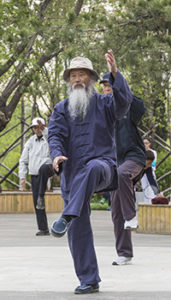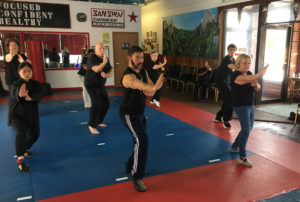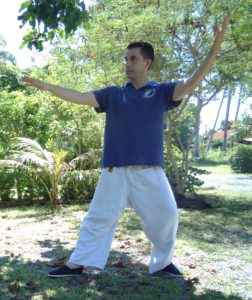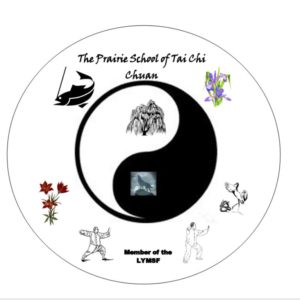Slanted FlyingJournal of Tai Chi Chuan
Philosophy
Softness, Sensitivity, and Science in Taijiquan
If practitioners are using an amount of force equivalent to the weight of a golf ball – about 45g pressure felt on the hand when the ball is held in one’s open palm – then the person represented by the blue line would sense any change greater than about 4.5g, whereas the opponent (red line) would sense any change greater than about 6.75g. The difference, about 2.25g, is roughly equivalent to the weight of a dime (US currency). Since this amount of weight is so slight, in effect, both participants will likely notice the changing (increasing or decreasing) pressure almost at the same time.
If the participants are practicing more forcefully, for example, at about 150g – the weight of a baseball (about three times the weight of a golf ball) – then the person represented by blue would sense any change greater than about 15g, whereas the opponent (red line) would sense any change greater than about 22.5g. The difference, about 7.5g, is roughly equivalent to the weight of three US pennies (or a 1 euro coin).
As can be deduced – from the red and blue lines getting farther apart at higher initial pressure levels – the greater the pressure being used, the greater the difference in the change of force between what each participant can detect, and the more likely that the more sensitive participant can react to the change before their opponent notices the change. This delayed response of the less sensitive participant can lead to a potential advantage for the more sensitive participant, but only if the level of force that is being used is sufficient to produce a noticeable lag in detection, and therefore a lag in the response of the less sensitive participant.
Thus, according to Weber’s Law, the more sensitive practitioner would benefit from interactions where more force is being used, at least as long as that level of force does not approach the maximum level that they are capable of, or are capable of sensing. If near their maximum, then they would be approaching the level where the stronger participant would win, regardless of their sensitivity levels, and Weber’s Law would no longer apply.
 While it may make sense to practice softly in order to train sensitivity, if a practitioner is more sensitive than their opponent, it makes scientific sense – according to Weber’s Law – to apply the art of Taijiquan using significant levels of power (force or pressure). It may be only at higher levels of force that differences in sensitivity become significant enough to give the more sensitive practitioner an advantage.
While it may make sense to practice softly in order to train sensitivity, if a practitioner is more sensitive than their opponent, it makes scientific sense – according to Weber’s Law – to apply the art of Taijiquan using significant levels of power (force or pressure). It may be only at higher levels of force that differences in sensitivity become significant enough to give the more sensitive practitioner an advantage.
On the other hand, Weber’s Law also suggests that practitioners who are less sensitive to changes in pressure would benefit by working with their partner or opponent less forcefully. At lower levels of force, the differences in sensitivity to changes in pressure are minimal, and both participants would likely sense the changes nearly simultaneously.
Another reason to practice softly is that it takes less effort to affect a light force than a heavy force. If you want to influence an opponent’s action, it is easier to do so when the force is light, before the force is “mature.” Most people understand that it takes less effort to toss and catch a basketball than it would a much heavier medicine ball of the same size, so I will not explain this principle further.
Of course, sensitivity (聽勁 tingjin, “listening” energy) is not the only relevant factor in practicing or applying Taijiquan. For example, if a practitioner can sense change, but does not understand (懂勁 dongjin) what the change means, then they cannot react appropriately. Another factor would be the speed of the interactions. Weber’s Law would apply to the ability to sense changes in speed, as well as many other aspects of interactions during Taijiquan, in a similar manner to this article’s explanations for pressure.
In martial arts like Taijiquan, what we attempt to do – in push-hands (推手 tui shou) and fighting – is to gain control of our opponent in such a way that they cannot respond appropriately to our attacks even when they can sense what is happening. If practitioners can succeed in controlling their opponent prior to attacking them, then they can reduce, or even eliminate, the effects of Weber’s Law as it relates to the ability to perceive changes, in strength (pressure), speed, movement, etc. It would not matter if they sense the attack if they are unable to effectively respond to it.
Examples of controlling the opponent include compromising their structure, “jamming” them so that they cannot fully express their power, deflecting them off target, “penetrating” their defenses, etc. If a practitioner cannot control their opponent prior to attacking them, then the stronger or faster or more sensitive participant will have some advantages. Weber’s Law shows that, when relying on the perception of changes, the better participant will be better over all ranges of that stimulus. This applies to all levels of force (whether soft or powerful) and all levels of speed (slow or fast), as well as many other factors that apply to interactions with an opponent.
Our abilities to apply Taijiquan principles should not depend on whether or not the opponent is forceful or fast. While we emphasize sensitivity, unless we are many time more sensitive than our opponent, Weber’s Law indicates that sensitivity may not be very important, especially when interacting at low levels of intensity (e.g., soft or slow). Understanding may be a more important factor in successfully applying Taijiquan to interactive situations. Understanding comes from practice, practice, practice.
Slowness and sensitivity in training promote understanding. Understanding allows control, and control produces the advantage in fighting.
Another factor that comes into play in Taijiquan is maintaining proper structure and energy. If we have to think before acting, or if we need to change our alignment, wind up, etc., the time needed would be increased, and this delay could be exploited by our opponent.
A properly inflated ball floating on water responds instantly to being touched, from any direction, due to its ideal round shape. If we can emulate the ball in our energy and structure, then our responses will not have delays; our responses will be “natural,” “spontaneous,” and “instantaneous,” irrespective of sensitivity, strength, or speed, and irrespective of Weber’s Law – which only applies to the mind’s ability to perceive differences.
In order to successfully apply Taijiquan principles, practitioners should seek conditions where Weber’s Law does not apply for factors like strength, speed, age, etc. Then the weak can defeat the strong, the slow defeat the fast, the old defeat the young, etc. Training improves understanding, understanding improves our ability to act appropriately to changes, as well as our ability to control our opponents, and control can negate, at least partially, the factors where Weber’s Law influences our interactions with opponents (i.e., the perceptions of changes).














One thought on “Softness, Sensitivity, and Science in Taijiquan”